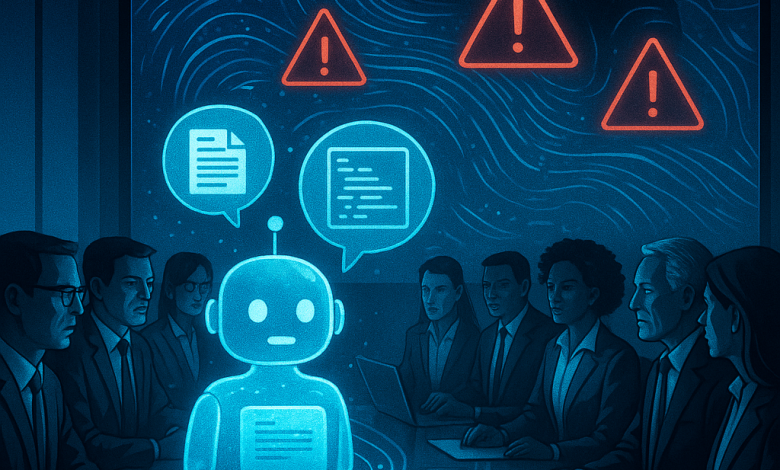
Business leaders now face a new threat: silent but steady risks tied to data leaks and privacy problems from generative AI (GAI) systems. These tools – chatbots, document creators, and more – are now a big part of daily work. Still, most companies do not have strong rules or oversight for how employees use them. The result? More security incidents, headaches with rules and laws, and legal trouble that can cost millions and hurt brand reputation.
Picture this: you have launched GAI tools to increase staff productivity, and the early numbers are compelling: productivity is up, and work quality is increasing as staff learn to use the technology. However, your AI could be a ticking time bomb.
Depending on your tech, all your prompts, generations and uploaded documents are being used to train the AI. AI companies like Open AI, Anthropic, Gemini, Grok, and DeepSeek want, and need, data for AI model training. But this also means that your data is outside your control, on external servers and frequently being reviewed by unknown people.
Most business leaders underestimate this real risk that AI systems pose to their companies. GAI chatbots have become a mainstay for handling customer care tickets, drafting legal memos, and writing code, but many leaders do not have a full grasp on how these tools vacuum up and store sensitive data. Worse yet, many companies still don’t have clear governance or policy for monitoring what gets sent into these platforms. The lack of visibility is not just a small oversight; it is a growing threat – with the risks extending far beyond the occasional embarrassing message.
And AI security risks are more than theoretical, a recent deep study of AI security risks by Cybernews highlighted actual incidents of AI security issues. The study reported that among S&P 500 AI deployments, 205 companies had AI incidents with Insecure Outputs: Data Leakage for 146 and 119 experienced Information or IP Theft.
The Silent Risk of AI Training
For instance, OpenAI keeps ChatGPT conversations and uploaded documents unless the user finds the link and ‘opts out’. Similarly, Meta uses data for AI training without any opt-out options, and in the EU, Meta adds friction by making people fill out forms to stop their data from being used.
Human reviewers add more risk for businesses, as well. Google’s team can read chats and keep copies even after a user deletes them. Microsoft allows people to review Copilot chats and doesn’t allow users to opt out of “safety” checks. OpenAI keeps deleted chats for 30 days, sometimes longer because of lawsuits. To put this into perspective, when staff paste company data into AI tools, that data can stay around for years, causing real problems for IT and security teams.
Every prompt entered into an AI chatbot, every file uploaded, and every generation request risks exposing or leaking extremely sensitive business data. Recent research found that over 4 per cent of user prompts to GAI platforms such as ChatGPT, Gemini, and Perplexity included confidential corporate information. Twenty-two per cent of uploaded files contained secrets like code, financial planning sheets, and legal strategy documents. Alarmingly, roughly half of these risky uploads occurred through free or personal accounts, or in other words, not the protected enterprise versions that offer tighter controls.
These incidents directly result from misunderstanding how GAI works. When staff use chatbots to manage work – often without proper oversight or policies – they may inadvertently expose trade secrets, customer data, or proprietary code. The danger grows when platforms quietly absorb the data for further model training, or when plug-ins and embedded AI features in products like design platforms and document editors collect inputs for undisclosed use. Many workers assume these tools are private or “safe,” despite clear evidence to the contrary.
Shadow AI: The Unseen Threat
Shadow AI refers to employees using popular GAI services outside the company’s sanctioned IT environment. Personal accounts make up a large share of data exposures. When staff use AI chatbots to manage work tasks from phones or home computers, they open company data to the public internet. Some of the largest corporate leaks have occurred this way, leading businesses like Samsung to ban AI tools after staff uploaded proprietary source code using personal accounts.
The genie is out of the bottle. With more than 0.75 billion AI-driven applications expected to be running globally by 2025, the chance of a quiet data leak happening in your office rises daily. By the end of next year, experts predict 80% of enterprises will have suffered at least one privacy incident linked to GAI.
The Model Memorizes More Than You Think
Large language models (LLMs), think ChatGPT and Gemini, train on millions of words scraped from the internet and user prompts. The way these systems “learn” means they sometimes memorize chunks of their training data. Clever prompts or prompt injection attacks, where users sneak in unexpected questions or instructions, can trick LLMs into revealing private details or proprietary information. In legal disputes, some companies have shown that these models can regurgitate exact phrases from confidential documents or licensed texts.
Even companies with privacy policies promising not to train their AI on user inputs routinely expand what data they collect. Automated filters for blocking personal information and securing uploads help, but hackers always look for new ways to bypass these checks.
When algorithms function as agents, handling decisions like refunds, contract execution, or cybersecurity interventions, they create new kinds of legal risk. AI agents can bind a company to actions or promises. Courts have already held businesses responsible for commitments made by chatbots – despite when mistakes arise from a hidden error or the bot’s lack of authority. These systems raise tricky questions about liability, especially as they integrate deeper into workflows without constant human oversight.
AI-Powered Cyberattacks and the Shifting Balance of Power
Threat actors have embraced GAI with enthusiasm. AI tools enable scalable social engineering, faster phishing, malware creation, and deepfake attempts. Some platforms now face adversarial prompt injection, data poisoning attacks, and model inversion – meaning both external hackers and rogue insiders can manipulate responses or extract information from the underlying “black box.” More than 87% of organizations have encountered AI-driven cyberattacks in the past year. Unfortunately, many current cyber defenses never anticipated these vectors and cannot keep pace with how quickly threats evolve.
This is because security teams often have a blind spot as many cannot even say where GAI is deployed within their company, or if policies exist for how employees should use these tools. As a result, exposures remain undetected until the damage mounts.
The Trust Problem: Blind Faith in Top Vendors
Companies leap aboard the GAI bandwagon, confident in big names like OpenAI, Google, or Microsoft to deliver safe products. But many features built for consumers – like data sharing, plug-in integrations, or open uploads – are unsafe for business needs. Even “enterprise” alternatives lag in offering critical controls for zero data retention and robust encryption. Low-reputation models – often downloaded from open-source repositories – can carry hidden code or vulnerabilities, and community checks rarely catch every problem.
Data Loss, Regulation, and the Weak Link: Humans
Regulatory demands grow stricter, with the European Union’s AI Act and new rules discouraging data maximization without clear business need. Yet enforcement lags, leaving companies to manage inconsistent policies and a patchwork of requirements. The weak spot is not always the tech, but the human staff. Too many users trust AI results blindly, skip security reviews, or ignore proper procedures. They assume, incorrectly, that chatbots know when to keep a secret.
An Eight-step Checklist for a Safer AI Future
Corporations need to go deep when selecting and integrating AI, especially for functions that have access to the most sensitive data. Earnings reports are among the most sensitive data since the numbers move markets; in preparing for the quarterly release, numerous departments have access to data including finance, communications, legal and c-suites, all of which probably use AI.
Corporations need a game plan and here is a basic check list about what works:
- Pick applications and LLMs with care. When you choose AI vendors:
- Look for security-first applications with clear info about training data sources, security and privacy.
- Choose tough technical safeguards. Demand strong encryption, access controls, and input checks. Watch all uploads and outputs. Use filters to flag and clean risky data.
- Choose strong security, including encryption, access controls, key security certifications, offer single-sign-on or on-premises LLM hosting.
- Proof they work in your industry or specific corporate function.
- Contracts that spell out data use, response to problems, and cover privacy or IP issues.
- Secure every endpoint. Enforce strong authentication for APIs, limit external access, and adopt input sanitization tools to block harm. Monitor all uploads and outputs and use automated filters to flag and clean risky data.
- Set Clear Policies. Bring together legal, tech, and business leaders. Track data flows, set clear ownership, and make rules for human review of risky AI use.
- Ban Shadow AI. Use of personal AI accounts is particularly dangerous, and it should be banned. And
- Run regular risk checks. Test for bias, privacy problems, and weak spots. Retest as models and data change. Use tools to stress-test AI agents in tough scenarios.
- Monitor in real time and plan for incidents. Track AI activity nonstop, keep audit logs, and be ready to act fast if something goes wrong.
- Insist on contractual clarity. Make vendors commit to privacy, security, and transparency. Require terms that share logs in case of an incident and push for indemnity protections for IP and privacy violations.
- Educate and train staff. Train your team in how GAI works, where its dangers lie, and how to spot errors. Incentivize responsible use. Treat all prompts and uploads as potential leaks and never trust AI-generated content without review.
GAI’s promise is real—but so are its costs if leaders do not act with urgency. The path forward is not to slow down; it is to professionalize. By following the eight step checklist above with the same rigor applied to financial controls, business leaders will capture AI’s upside – without gambling the franchise.




